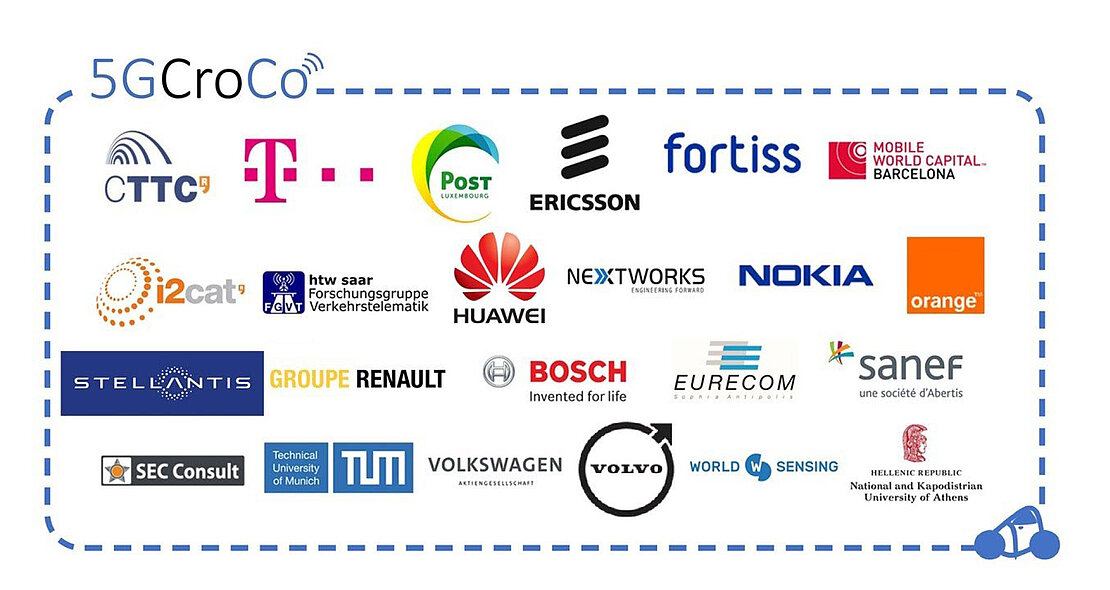5GCroCo H2020 EU - Project: Seamless Connected and Automated Mobility in Europe

The objective of 5GCroCo is to validate key 5G technologies in challenging cross-border, cross-mobile-network-operator, cross-car-original-equipment-manufacturer, and cross-telco-vendor scenarios. The project concentrates in particular on cutting-edge technologies such as 5G New Radio, service continuity, Mobile Edge Computing/Cloud, end-to-end and predictive Quality-of-Service, network slicing, virtualization, network support for precise positioning, and security.
Furthermore, 5GCroCo is exploring innovative business models. It will contribute to the definition of the necessary policy and spectrum regulation to guarantee the success of 5G for connected and automated mobility (CAM) services. The impact of 5GCroCo is also present at the standardization level for both the telecom and the automotive industries (3GPP, ISO, etc.). 5GCroCo is thus contributing to the consolidation of Europe’s leading role in 5G technology, paving the way for the commercial deployment of 5G for CAM in Europe and worldwide.
The results obtained so far in the project and through the three use cases show that cross-border/-mobile-network-operator handover works seamlessly and that the use of 5G networks is key to reducing the end-to-end latency, which is critical in CAM applications, such as the ones studied in the 5GCroCo use cases. Moreover, additional results show that, thanks to Mobile Edge Computing / Cloud technology, more stable delays can be achieved than when relying on public internet for the hosting of applications. Furthermore, a significant increase of the transmission speeds has been measured in the 5GCroCo tests and trials.
1st use case: Tele-operated Driving (ToD)
Tele-operated Driving technically enables the deployment of truly driverless vehicles through remoteoperation of the vehicle from a Vehicle Control Center (VCoC). Specifically, a connection is established from the VCoC to the vehicle via a 5G mobile network. This allows the transmission of sensor data, in particular video, from the vehicle to the VCoC and control commands from the VCoC to the vehicle.
2nd use case: High-Definition map generation and distribution for automated vehicles (HD Mapping)
HD Mapping technology allows vehicles to collectively contribute to keeping high-definition maps up to date. Using the connection to a 5G mobile network, vehicles send map updates gathered from sensor data to a common backend, which takes care of merging all these inputs to maintain an accurate HD map. The reliable HD map is then re-distributed to the cars together with up-to-date information regarding lanemarkings, speed signs, and other essential information for the autonomous driving function in the car.
3rd use case: Anticipated Co-operative Collision Avoidance (ACCA)
G-enabled ACCA technology will allow for any occurrence of road event, such as a traffic jam, to be communicated to vehicles in the vicinity. As a result, corrective actions such as progressive braking can be anticipated to induce smoother and more homogeneous vehicle reactions in situations when typical sensors will have no visibility or a short detection range (a few hundred meters).
Summary
The three and a half-year initiative, which, out of the total € 17 million budget, has received close to € 13 million in funding from the European Commission under the umbrella of the 5G Public Private Partnership (5G PPP), gathers 24 partners from seven European countries, including key organizations from both the telecom and the automotive worlds. 5GCroCo coordinates contributions from leading car manufacturers, tier-1 suppliers, road authorities, mobile network operators, telecom vendors and academia.
Find out more at 5GCroCo website